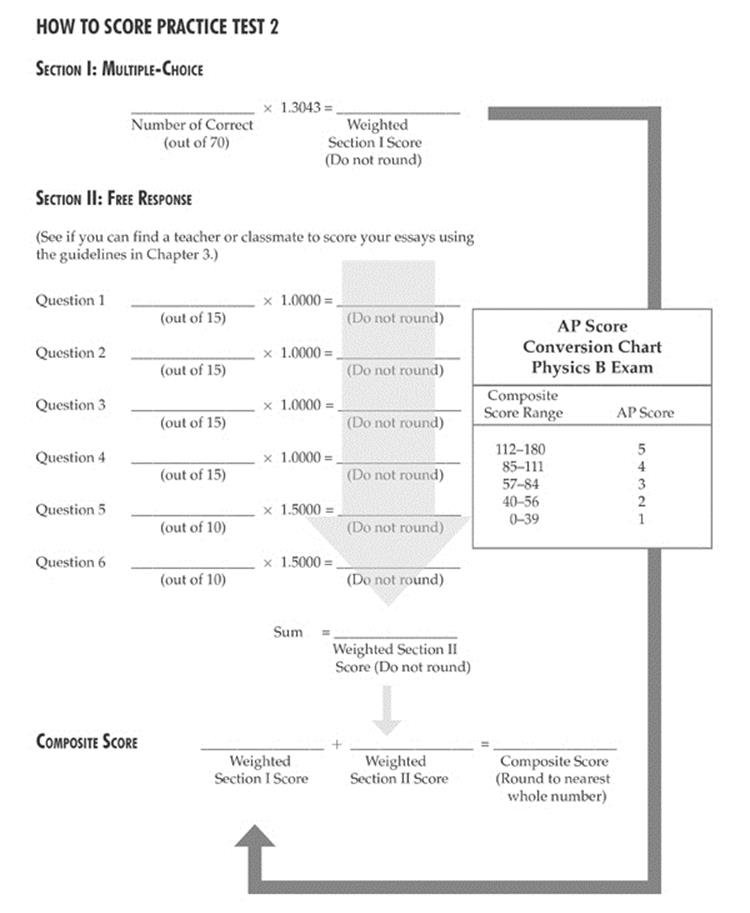AP Physics B Exam
22 AP Physics B Practice Exam 2: Answers and Explanations
SECTION I
1. B When the net force acting on an object is zero there is no acceleration, therefore no CHANGE in velocity. I. is not correct because the object could be at a constant nonzero velocity. III. is not correct because you could have two forces acting on the object in opposite directions that cancel each other out.
2. E ![]() = may → T – mg = ma or T = ma + mg. This means T = (1500 kg)(2 m/s2) + (1500 kg)(10 m/s2) = 18,000 N
= may → T – mg = ma or T = ma + mg. This means T = (1500 kg)(2 m/s2) + (1500 kg)(10 m/s2) = 18,000 N
3. E The velocity is tangent to the circle in the direction of motion. Both the acceleration and force point toward the center of the circle.
4. D The velocity is least at the top so the kinetic energy is least at the top. The other answers are incorrect because at the top the ball has a horizontal component of velocity so the velocity can not be zero, there is a vertical acceleration of –10 m/s2 throughout the trip, and the potential energy is maximum at the top.
5. B The volume of water displaced is 200 mL (1,200 mL – 1,000 mL). Because the density of water is 1 g/mL, we can find the mass by m = ρV → m − 1![]() (200mL) = 200g of water. 200 g of water weighs 2 N (from Fg = mg → Fg = 0.2 kg(10 m/s2). Archimedes” principle states the weight of the water displaced is equal to the buoyant force. Therefore there is an upward force of 2 N acting on the mass. A 0.50 kg mass weighs 5 N. The spring scale will read 3 N (5 N – 2N).
(200mL) = 200g of water. 200 g of water weighs 2 N (from Fg = mg → Fg = 0.2 kg(10 m/s2). Archimedes” principle states the weight of the water displaced is equal to the buoyant force. Therefore there is an upward force of 2 N acting on the mass. A 0.50 kg mass weighs 5 N. The spring scale will read 3 N (5 N – 2N).
6. D Mechanical energy is conserved when there is no heat loss due to friction. The period of objects undergoing simple harmonic motion is constant. The velocity is continually changing so momentum of the mass is not conserved.
7. C fspring =  and fpendulum =
and fpendulum =  . Setting these two equal to each other:
. Setting these two equal to each other:  which becomes
which becomes  or
or  or
or ![]()
8. D Tpendulum =  Changing the mass or amplitude has no effect on the period. The square root of one fourth the length reduces the period by a factor of 2.
Changing the mass or amplitude has no effect on the period. The square root of one fourth the length reduces the period by a factor of 2.
9. D Using conservation of momentum, m1v1i + m2v2i= (m1 + m2)vf. This becomes 2MV0 + M(0) = (2M + M)vf. Solving for vf you get (D).
10. A Gravity is given by g =  . Doubling the radius yields one-fourth gravity. Reducing the mass cuts the gravity in half. One-fourth of one-half is one-eighth.
. Doubling the radius yields one-fourth gravity. Reducing the mass cuts the gravity in half. One-fourth of one-half is one-eighth.
11. D The slope of the tangent line gives the instantaneous velocity. You could also use Process of Elimination. Recognize the answer must be negative, so you can eliminate (A), (C), and (E). The point in question is at (9,4). Dividing the y coordinate by the x coordinate is not the same as the obtaining the slope and is there to distract you.
12. A Statement I is correct because by conservation of energy, the heat lost by one object must be gained by the other. The temperature change depends on the equation ΔQ = mcΔT. Because the water has both more mass and a higher specific heat, there will be a much lower temperature change of the water than the Al. Similarly, the internal energy of the object is given by ΔQ = mcΔT. Although at the same temperature, the water again has both more mass and a higher specific heat and therefore more internal energy.
13. C The work done by a gas is determined by the area under a P vs. V graph. Because path C has the greatest area it does the greatest amount of work.
14. A The magnitude of the force is given by F = qvB. Doubling the charge doubles the force, doubling the velocity doubles the force, although doubling the mass will reduce the acceleration, it will not affect the force.
15. D All statements are true.
16. B First examine the two capacitors in series. The capacitors in series follow the rule  . For two capacitors of equal value in parallel, the total capacitance is reduced by two. Once the series section is taken care of, the two branches in parallel can be determined by Cp =
. For two capacitors of equal value in parallel, the total capacitance is reduced by two. Once the series section is taken care of, the two branches in parallel can be determined by Cp = ![]() . This means the two branches can simply add. 1C+ 1/2 C = 3/2 C
. This means the two branches can simply add. 1C+ 1/2 C = 3/2 C
17. A The resistance is given by R = ![]() . Using the same material means ρ is constant. Cutting the length in half will reduce the resistance by a factor of 2. Cutting the radius in half or doubling the radius will change the resistance by a factor of 1/4 (or 4) because A = πr2. The only correct answer is (A).
. Using the same material means ρ is constant. Cutting the length in half will reduce the resistance by a factor of 2. Cutting the radius in half or doubling the radius will change the resistance by a factor of 1/4 (or 4) because A = πr2. The only correct answer is (A).
18. C P = IV means the electrical power is P = (1A)(120V) = 120 W. If this motor is only 75% efficient we get (0.75)(120 W) = 90 W of power output. Also P = Fv. Lifting a 6 kg mass upward at a constant velocity requires a 60 N force (by Fg = mg → (6 kg)(10 m/s2). Therefore v = P/F or v = 90W/60N = 1/.5 m/s.
19. D The two electric fields vectors are shown. The resultant can be determined as shown below.
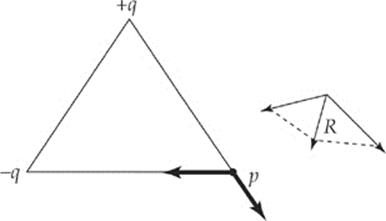
20. E Charges do not create an electric field at the location of the charge itself. Therefore the electric field at point p is not changed by the addition of a charge at point p.
21. A Path a follows the right-hand rule so must be positively charged. Path b is opposite the right hand rule so must be negatively charged. Neutrons would follow a straight line path, so it is impossible for either a or b to be a neutron.
22. E The change in length of a rod is given by ∆![]() = α
= α![]() o∆T. Because α is a very small number, the length of a rod will be very much constant for a small temperature change. Formally, ∆
o∆T. Because α is a very small number, the length of a rod will be very much constant for a small temperature change. Formally, ∆![]() = α
= α![]() o∆T becomes ∆
o∆T becomes ∆![]() = (25 × 10–6 1/°C)(
= (25 × 10–6 1/°C)(![]() o)(10°C) = 2.5 × 10–6
o)(10°C) = 2.5 × 10–6![]() o.
o. ![]() =
= ![]() o + ∆
o + ∆![]() or
or ![]() o + 2.5 × 10–6
o + 2.5 × 10–6![]() o. Again, this is just about
o. Again, this is just about ![]() .
.
23. D Isochoric means constant volume. Also the average speed of the molecules is given by vrms =  so increasing T increases the speed and therefore the number of collisions. From the ideal gas law PV = nRT so keeping a constant volume means increasing T also increases P. Kave =
so increasing T increases the speed and therefore the number of collisions. From the ideal gas law PV = nRT so keeping a constant volume means increasing T also increases P. Kave = ![]() kbT tells us the kinetic energy increases as the temperature does.
kbT tells us the kinetic energy increases as the temperature does.
24. A The rules for ray-tracing diagrams state that a line parallel to the principle axis bends away from the focal point as shown.
25. D Resonance occurs at λ = ![]() for odd integers. This means at 4L,
for odd integers. This means at 4L, ![]() L,
L, ![]() L,…. We are shown a picture where a wave is in a tube of length L. This means λa =
L,…. We are shown a picture where a wave is in a tube of length L. This means λa = ![]() . The next shorter wavelength is λb =
. The next shorter wavelength is λb = ![]() . The ratio of these is
. The ratio of these is  or 5/3.
or 5/3.
26. E Statements I and II are true for a diverging (concave) lens. Statement III is true for a converging lens, not a diverging lens.
27. A v = fλ so ![]() = f. f =
= f. f =  → 0.5 × 1016 Hz
→ 0.5 × 1016 Hz
28. E Because sound is a longitudinal wave it cannot be polarized. Both longitudinal waves (sound) and transverse waves (light) can diffract (bending and spreading as it passes through an opening). Both can also refract (change speeds as the wave enters a new material).
29. D The positive area above the curve cancels the negative area below the curve to have zero work done. Another way of examining this problem is recognizing the velocity at the top and bottom of the bounce is zero. With no change in velocity there is no change in kinetic energy and therefore no net work done.
30. E The work done is given by the area under the curve. The maximum velocity occurs when there is a maximum positive area or from 0 to 4 cm. This area is given by A = 1/2 bh = ½ (0.04 m)·(20 N) = 0.4 N·m. The work done also gives the change in kinetic energy so we can say K = ½ mv2 = 0.4 N·m. This becomes ½ (0.2kg)(v2) = 0.4 N·m which becomes 0.1v2 = 0.4 N·m or v = 2 m/s.
31. E Ft = mΔv → F =  → 300N
→ 300N
32. D 100 g weighs just about 1 N (Fg = mg → Fg = 0.1 kg(10 m/s2) and τ = dF → (25cm)(1N) = 25N·cm
33. B For the bar to balance τccw = τcw or dLFL = dRFR. Furthermore the uniform stick can have its mass considered at the 50 cm mark which is 25 cm from the finger (fulcrum). This means dLFL = dRFR becomes (25 cm) FL = (25cm)(1N) or the stick weighs 1N which corresponds to a mass of 100g.
34. E If you double the wavelength you reduce the frequency by a factor of two. As soon as you are below the threshold frequency no photons are emitted.
35. B Given v = fλ we know f = 
36. B The lower number must remain 6 for carbon because the number of protons is equivalent to the atomic number. The upper left number is the sum of the protons and neutrons (6 + 7 = 13).
37. D The pressure in a non-moving fluid depends strictly on the depth.
38. B Because the fluid is higher in column B, the air speed must be greater above column B. This must be due to a narrower tube.
39. A To determine the density you need both the mass and the volume. From the picture, when the ball floats it displaces 100 mL of water (300mL – 200mL). This is equivalent to 100g of water from m = ρV and the density of water is 1g/mL. This weighs just about 1N (from Fg = mg → Fg = 0.1 kg(10 m/s2). When an object floats the buoyant force is equal to the weight of the object so the object weighs 1N which means the mass of the object is 100g. When an object is submerged the object displaces an amount of water equal to the object”s volume. Therefore the volume of the object is 300 mL (500mL – 200mL). The density is now given by ρ = 
40. B Conservation of momentum tells us for a closed system pi = pf. Because the two students start at rest, the initial momentum is zero.
0 = mGvG + mKvK → −mGvG = mKvK →  . You might have been told by your physics teachers always to use SI units and have an initial reaction to convert to kg. However, you know that mass is proportional to the weight and any conversion would appear in both equations and just cancel out. You can save some time by not converting (essential when trying to solve 70 problems in 90 minutes). The ratio is –4/3. The negative simply tells a direction and can be ignored.
. You might have been told by your physics teachers always to use SI units and have an initial reaction to convert to kg. However, you know that mass is proportional to the weight and any conversion would appear in both equations and just cancel out. You can save some time by not converting (essential when trying to solve 70 problems in 90 minutes). The ratio is –4/3. The negative simply tells a direction and can be ignored.
41. B From the picture you can see there is no acceleration in the y direction because the upward and downward forces cancel. We can also determine the mass of the object because FG = mg → 20N = m(10 m/s2) → m = 2.0kg. In the x direction we have ![]() This becomes Fs − FF = max → ax =
This becomes Fs − FF = max → ax =  = 2.5 m/s.
= 2.5 m/s.
42. C The centripetal force is provided by gravity. Setting Fg = Fc we get  . Rearranging terms yields
. Rearranging terms yields  .
.
43. D By accelerating upward at 10 m/s2 you are effectively experiencing 2 g”s of acceleration. The period of a mass hanging from a spring does not depend on gravity, the period of a pendulum does. T =  so as g increases, T decreases.
so as g increases, T decreases.
44. D a = ![]() . If F is constant but mass decreases the acceleration will increase. As the acceleration increases the slope of a velocity-vs.-time graph will also increase.
. If F is constant but mass decreases the acceleration will increase. As the acceleration increases the slope of a velocity-vs.-time graph will also increase.
45. A W = Fd. The force needed to push the charge from V1 to V2 is q V.
46. C The work done causes a change in kinetic energy. Because the particle starts from rest W = K. This becomes q(V2 − V1)d = ![]() mv2 →
mv2 → 
47. C Conventional current flows out of the positive side of the battery (the longer (left) side on the battery schematic). Therefore the current in A is CCW. The right-side section of wire in A produces a magnetic field on the right of the loop that is into the page as given by the right-hand rule. Therefore the flux in the B loop is into the page. As loop B moves away from loop A, the flux into the page decreases. From Lenz”s Law a current will be produced in B in order to oppose this decrease in flux. This would require a CW current as given by the right-hand rule.
48. A The voltage across the 6000 Ω resister is given by V=IR or (0.001A)(6000 Ω) = 6V. In a parallel circuit the voltage across both branches is the same and so the total voltage drop across R1 and the 1000 Ω resistor must also be 6V. The voltage across R1 and the 1000 Ω will add to 6V because they are in series. Because there is 4V across the 1000 Ω resister, there must be 2V.
49. E The current through the 1000 Ω resistor is given by I = V/R or 4V/1000 Ω = 0.004 A. The current of the two branches will sum up to the current flowing out of the battery in a parallel circuit. IB = 0.004A + 0.001A = 0.005A or 5 mA.
50. C The larger the angle when measured from the normal, the smaller the index of refraction. Because the angle in A > angle in C > angle in B, nA < nC < nB.
51. E Water has a higher index of refraction than air, so if light refracts through the water the light will bend away from the normal—so C is possible. Another possibility is D, total internal reflection when the angle in water is greater than the critical angle.
52. C The velocity of the alarm is away from the detector so the frequency will lower due to the Doppler effect. As the speed increases away from the detector, due to the downward acceleration of gravity, the frequency will get even lower.
53. A Reflections are inverted when the new medium has a higher index of refraction. Reflections are not inverted when the new medium has a lower index of refraction. Because nfilm>nair there is an inversion on the top, but not the bottom.
54. D The thin lens equation is given by  . Images formed behind a mirror have a negative in front of them.
. Images formed behind a mirror have a negative in front of them.  or f = –5/2 cm. This answer makes sense because the focal length of a diverging mirror is negative.
or f = –5/2 cm. This answer makes sense because the focal length of a diverging mirror is negative.
55. E The intensity of the light does not affect the focal length.
56. E The rate at which heat is transferred is given by H =  . The material does not change, nor does the change in temperature, so k and ∆T won”t affect the answer. In figure a the area is (L)(2L) or 2L2. The length is 4L. This means the initial rate is H =
. The material does not change, nor does the change in temperature, so k and ∆T won”t affect the answer. In figure a the area is (L)(2L) or 2L2. The length is 4L. This means the initial rate is H =  . In figure b the area is given by (L)(4L) or 4L2 and the length is 2L. The heat flow for b is H =
. In figure b the area is given by (L)(4L) or 4L2 and the length is 2L. The heat flow for b is H =  → H = 2kLΔT. Figure b has four times the rate as figure a.
→ H = 2kLΔT. Figure b has four times the rate as figure a.
57. C The maximum efficiency of a heat engine is given by e =  using the Kelvin temperature scale. This means you have to add 273 to each answer to get 300K and 500K. The efficiency becomes e =
using the Kelvin temperature scale. This means you have to add 273 to each answer to get 300K and 500K. The efficiency becomes e =  or 40%.
or 40%.
58. C The number of neutrons in an element can be found by taking the atomic mass minus the atomic number. For Thorium this becomes 234 – 90 = 144 and for Uranium this becomes 238 – 92 = 146. The ratio is therefore 144/146.
59. E All conservation rules are obeyed. Charge is conserved (92 – 90 + 2). The number of nucleons is conserved (92 protons + 146 neutrons) = (90 protons + 144 neutrons) + (2 protons + 2 neutrons). Mass–energy is conserved (238 = 234 + 4).
60. C The power is equal to 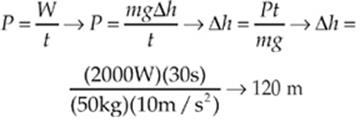
61. E The horizontal component of a projectile is constant (5 m/s). The vertical velocity at the top is zero. The acceleration due to gravity is constant at –10 m/s2.
62. C As the time goes by the projectile rises and falls. Therefore the gravitational potential energy must increase and then decrease. Using conservation of energy, the kinetic energy must decrease and then increase. This lets us eliminate choices (A) and (B). The parabolic shape of a projectile lets us eliminate (E). Because there is some horizontal velocity at the top the kinetic energy can not be zero and (D) can be eliminated.
63. A The small cart starts with no kinetic energy because it is at rest. The large cart starts with K = ![]() (4M)v2 → K = 2Mv2. If it gives half its kinetic energy to the small cart it transfers K = Mv2. The equation for the kinetic energy of the small cart is now Mv2 =
(4M)v2 → K = 2Mv2. If it gives half its kinetic energy to the small cart it transfers K = Mv2. The equation for the kinetic energy of the small cart is now Mv2 = ![]() (M)vf2 → 2v2 = vf2 → vf =
(M)vf2 → 2v2 = vf2 → vf = ![]() or 1.41v.
or 1.41v.
64. D The right-hand rule lets us determine that the solenoids will behave like magnets as shown.

Because south poles of magnets repel south poles, and they attract north poles of magnets, we choose (D).
65. B The work done moving a particle against an electric field is given by W = qEd. Work is also equal to the change in kinetic energy. Because the final velocity is zero we can say  . Cutting the mass in half cuts the distance in half but doubling the velocity makes the distance 4 times bigger. These factors combines to give the answer, (B).
. Cutting the mass in half cuts the distance in half but doubling the velocity makes the distance 4 times bigger. These factors combines to give the answer, (B).
66. E The field lines are neither evenly spaced nor parallel so the field is not uniform. The field lines point away from A and B and so both charges are positive and a positive charge would move in the direction of the field line away from B. (E) is true.
67. A Knowing the equations for circular motion F = ![]() and v =
and v = ![]() we can substitute in to get
we can substitute in to get 
68. E There is no work done on the stopper because the force applied is perpendicular to the direction of velocity and the kinetic energy does not change. Therefore, there is no power developed.
69. C The force acting on a particle moving through an electric field is given by F = qE. The force acting on a charge moving through a magnetic field is equal to F = qvB. Setting these two forces equal to each other we get qE = qvB or E = vB. Therefore 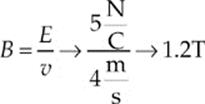 . To determine the direction we know the force acting on the particle must be downward to counteract the upward push due to the electric field. Using the right-hand rule, we know the magnetic field must point out of the page.
. To determine the direction we know the force acting on the particle must be downward to counteract the upward push due to the electric field. Using the right-hand rule, we know the magnetic field must point out of the page.
70. B The electric field is given by E = ![]() where r is measured from the center of the sphere to the point in question.
where r is measured from the center of the sphere to the point in question. 
 . Substituting Eb for the kq in the first equation becomes
. Substituting Eb for the kq in the first equation becomes  .
.
SECTION II
1. (a) The height of the table and the distance the two blocks move horizontally can help us determine the speed of the blocks the moment before they leave the table. The time falling only depends upon the height of the table.

We know that the blocks leave the table horizontally so that there is no initial y velocity and this simplifies to
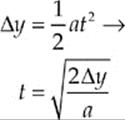
Substituting in this becomes
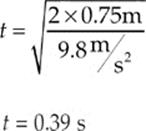
Knowing vx is constant, the time falling and the horizontal distance, we can get
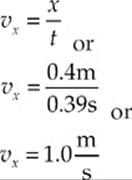
(b) We now know the final velocity, the instant the blocks leave the table. We can treat the problem like a momentum problem.
![]()
Because we are looking for the mass of B we can rearrange this to become:
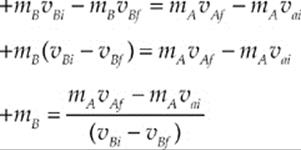
Substituting in the known numbers:

Or mB = 0.25kg
To determine the energy loss we simply have to compare the initial and final kinetic energies. Block B is initially at rest and so has no kinetic energy. Block A initially has a kinetic energy given by:
Ki = ![]() mAvAi2. When you substitute in you get Ki =
mAvAi2. When you substitute in you get Ki = ![]() (0.5 kg)(1.5
(0.5 kg)(1.5![]() )2 = 0.56 J.
)2 = 0.56 J.
Because the two blocks hit and stick we can consider them together.
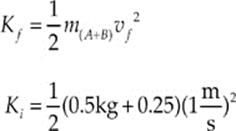
or Kf = 0.375 J
The energy lost can be correctly expressed either of two ways—as a difference or a percentage.
Difference: Subtract the total final energy from the total initial energy.

Percentage.
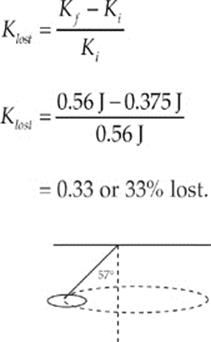
2. (a) A free-body diagram would include only the tension in the string and the force of gravity as shown below. Because it makes a horizontal circle take some care to draw the direction of the force represented by tension along the path of the string.

(b) Where θ is the angle between FT and

And

(c) The centripetal force is the net force in the x direction. However, we need to use some information from the y direction. Because the conical pendulum travels in a horizontal circle there is no acceleration in the y direction and so Newton”s Second Law in the y direction becomes
![]()
or
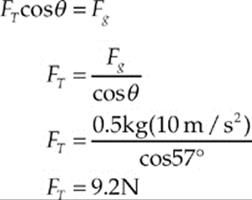
Knowing this we can solve for the centripetal acceleration. It is the same as the acceleration in the x direction.
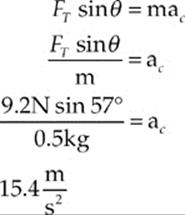
(d) The radius the ball travels in can be found using some geometry. The length of the string is 2.2 m at an angle of 57 degrees. This means
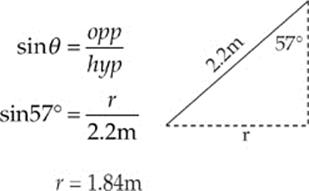
(e) The ball will travel at a speed of
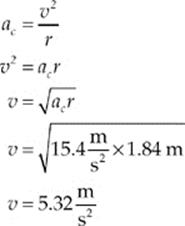
3. (a) The electric field is given by both

This lets us write
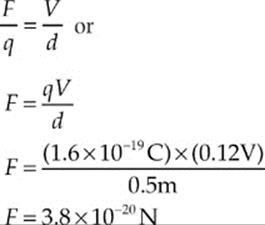
Because the charges have the same magnitude and only the opposite direction, the voltage is the same except for the opposite direction, and the distance is the same, the charges will experience equal forces.
(b) Because we know the force and distance, we can use either W = ∆K to become
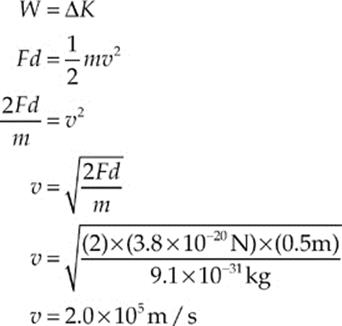
for the electron and

(c) for the proton. The speed of the proton is only about 2% the speed of the electron. The charges will experience a magnetic force once they enter the magnetic field given by F = qvB. The force is perpendicular to the direction of motion so that the charges also obey the circular motion equation F = mv2/r. A sketch would look like:
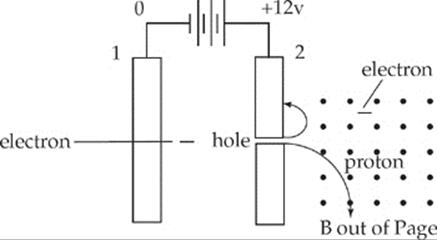
Setting these two forces equal to each other we have:
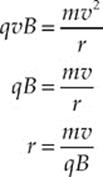
A proton will have a radius given by:
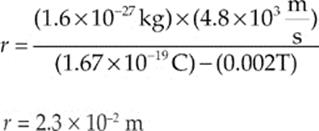
An electron will have a radius given by:
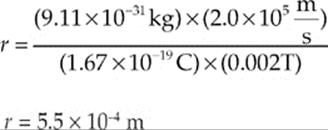
The charges will each hit the wall one diameter”s distance away so we can double the above two radii and see them strike the plate.
The proton strikes 4.6 × 10–2 m below the hole. The electron strikes 1.1 × 10–3 m above the hole. The charges will strike 0.047 m apart.
(d) The time it takes to complete one circle would be given by v = ![]() if it traveled the full circle, but it only travels half way around so that we have
if it traveled the full circle, but it only travels half way around so that we have

The proton will take

T = 1.5 × 10–5 s for a proton and

T = 8.6 × 10–9 s for an electron
4. (a) The equivalent resistance of the circuit can be found by first calculating the resistance of the two resistors in parallel and then adding that value to the resistor in series. For parallel circuits:
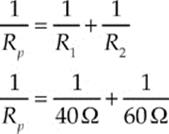
This means Rp is 24 Ω. The total resistance of the circuit is thus
Rs = R1 + R2 = 24 Ω+20 Ω or 44 ohms.
(b) Because P = IV and V = IR we can substitute in to obtain
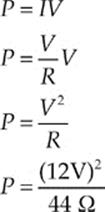
or P = 3.27 W
(c) The energy transferred in 15 minutes is given by:
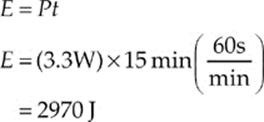
(d) The energy added goes into heat. This is given by ΔQ = mcΔT. We also need to know the density of water is 1g/mL so that 1000 mL equals 1000 g. Therefore our heat equation becomes
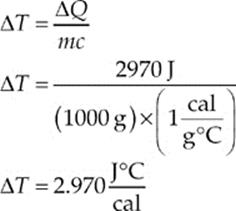
Because 1 cal is 4.186 J we can simplify this to

This means the final temperature of the mixture is 10.7 ºC
5. (a) Any image that can be formed on a screen is a real inverted image.
(b) The thin lens equation states  . Picking the first two data points 15 and 61.5, we obtain
. Picking the first two data points 15 and 61.5, we obtain
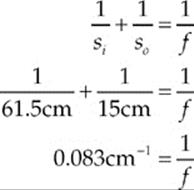
Thus, f = 12 cm
if an image is placed 6 cm away from the lens we have
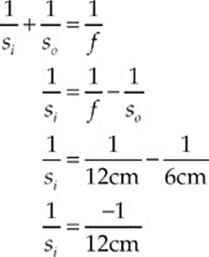
or si = –12 cm. This is a virtual upright image.
(c) A ray-tracing diagram would look something like this.
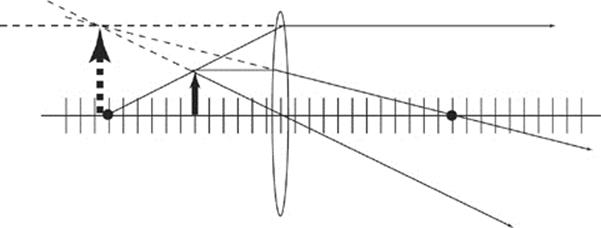
The diameter of the lens only affects the ability to gather light. It would decrease the brightness of the image but not change the location of the image.
6. (a) For a double slit experiment, Xn = ![]() . Solving for d we get:
. Solving for d we get:
d = ![]()
d = 
Or d = 6.7 × 10–6m
(b) For the third-order maximum the path difference is 3λ. This would simply be
(3) × (4.7 × 10–7m) or 1.4 × 10–6m
(c) The third-order maximum for the new laser is
Xn = ![]()
X3 = 
or 0.56 m. This means the two third-order maxima are 0.56 m – 0.42 m or 0.14 m apart.
